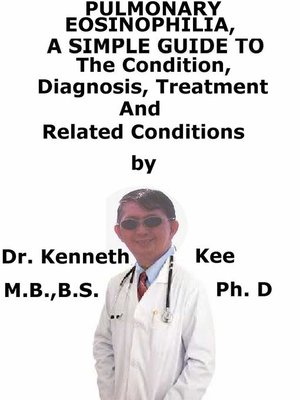Pulmonary Eosinophilia, a Simple Guide to the Condition, Diagnosis, Treatment and Related Conditions
ebook
By Kenneth Kee

Sign up to save your library
With an OverDrive account, you can save your favorite libraries for at-a-glance information about availability. Find out more about OverDrive accounts.
Find this title in Libby, the library reading app by OverDrive.



Search for a digital library with this title
Title found at these libraries:
| Loading... |
This book describes Pulmonary Eosinophilia, Diagnosis and Treatment and Related Diseases
Eosinophilia may not seem a dangerous illness when it is present as the only cause of the medical illness that happened to my middle aged patient 2 weeks ago.
After about 50 years free from asthma and severe allergic rhinitis, he had a severe attack of asthma and rhinitis for almost 2 months before he consulted me.
Even with medication from other general practitioners, he was so breathless that he was unable to sleep at night.
Most nights he sat on the floor gasping for breath while using hundreds of paper tissues to dry his dripping nose.
Antihistamines and bronchodilators had little effect on him.
He eventually fell asleep sitting down with blankets covering him and hanging on to the side of the beds.
Only when mornings come did he feel better although he was still breathless and his nose still dripped.
He was taken to the doctor every morning for an injection of aminophylline and antihistamine which reduced his symptoms partially.
In the end when he saw me he had lost 2 kgs of weight and was so exhausted that he can hardly keep his eyes open.
I decided to start him on corticosteroids which appeared to reduce his symptoms especially at night.
Eventually I forced him to take a chest X-rays and complete blood tests including tumor markers to exclude any possible cancer.
His chest x-rays and blood tests were normal but his eosinophils were particularly high >5,000 eosinophils/microL.
Stool tests for ova and blood were normal and more likely eliminate any parasitic disease.
Eosinophils are particularly high in allergic conditions and in parasitic infections.
I had his air conditioners cleaned to exclude any dust or mites that may cause him any allergy.
He was also told to avoid any herbs or Chinese medicines.
He was also told to use ventolin (reliever) and steroid (preventer) inhalers.
He had since then improved and his steroid tablets dosage had been reduced.
Much has been mentioned about bacterial infection being an important cause of death in the human person and less on allergy causes of lung diseases such as asthma, chronic lung disease, and pulmonary fibrosis being a large cause of death in humans.
Pulmonary eosinophilia is the infiltration of eosinophils into the lung compartments comprising airways, interstitium, and alveoli.
Higher quantities of eosinophils in the lungs have been linked with:
1. Different infections,
2. Drugs,
3. Parasites,
4. Autoimmune processes,
5. Malignancies and
6. Obstructive lung diseases.
Fungal infections and parasitic infestations are often causes of pulmonary infections in immunocompromised patients that can end in deaths more often than bacterial pnuemonias.
Many people may not realize it but asthma, fungal pneumonia are a main source of dangerous lung diseases.
Pulmonary eosinophilia may be broadly categorized into:
1. Primary/idiopathic and
2. Secondary/extrinsic from external factors
Most incidents of this disorder are due to an allergic reaction from:
1. A medicine, such as a sulfonamide antibiotic or a non-steroidal anti-inflammatory drug (NSAID), such as ibuprofen or naproxen
2. Infection with a fungus such as Aspergillus fumigatus or Pneumocystis jirovecii
3. A parasite, such as the roundworms Ascariasis lumbricoides, or Necator americanus, or the hookworm Ancylostoma duodenale
In some cases, no cause is evident and the disease is called Primary pulmonary eosinophilia.
The treatment of PE is dependent on the underlying cause and...






